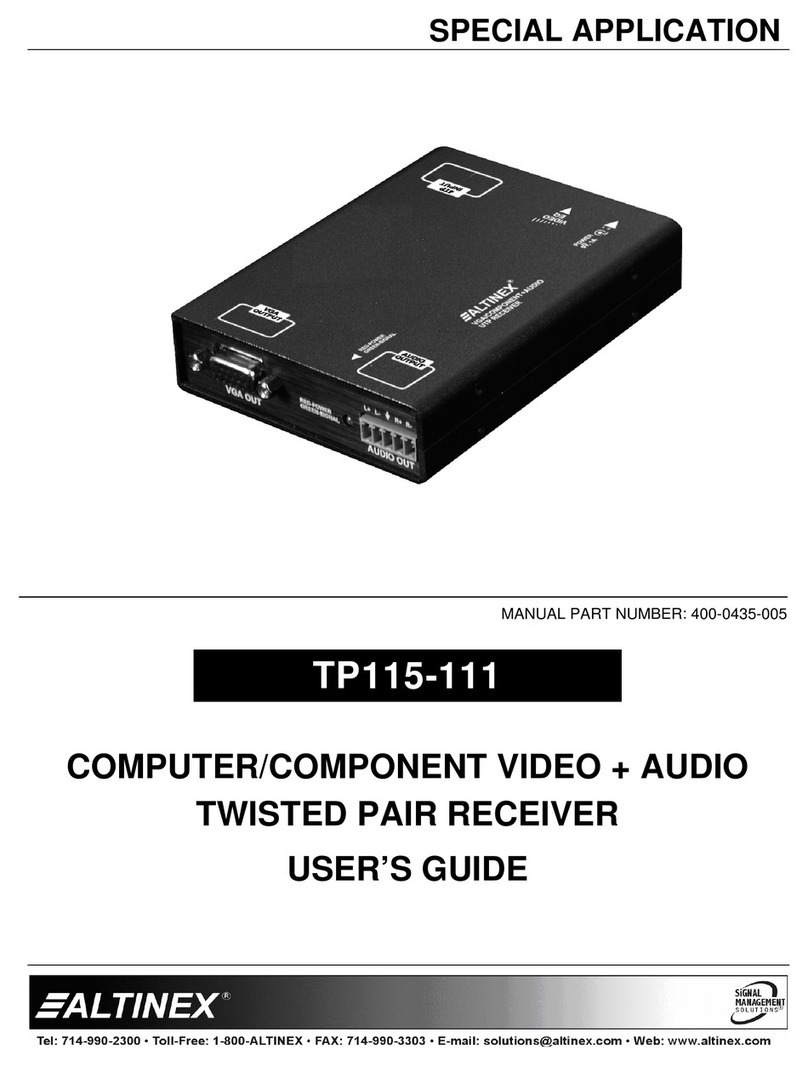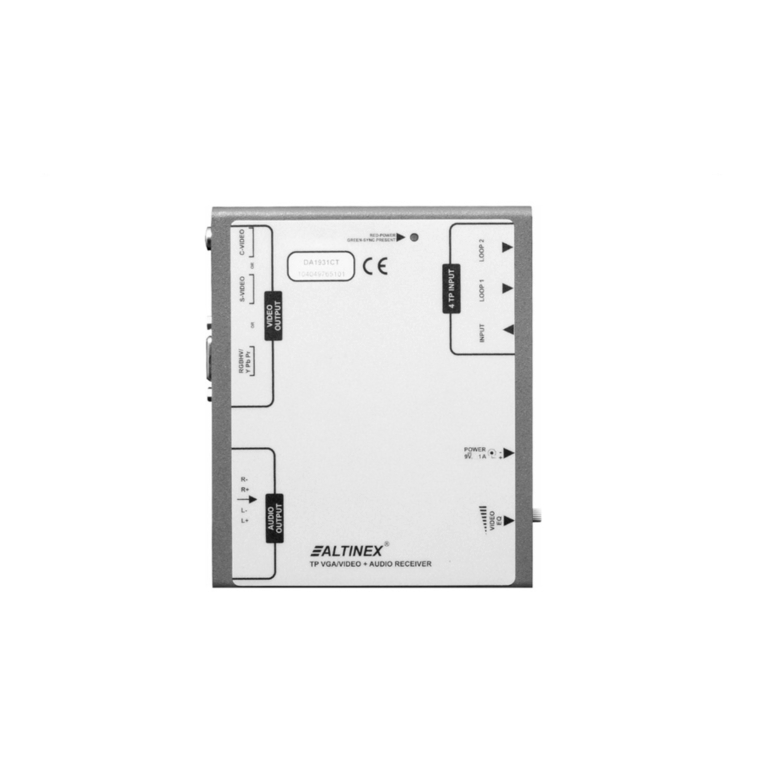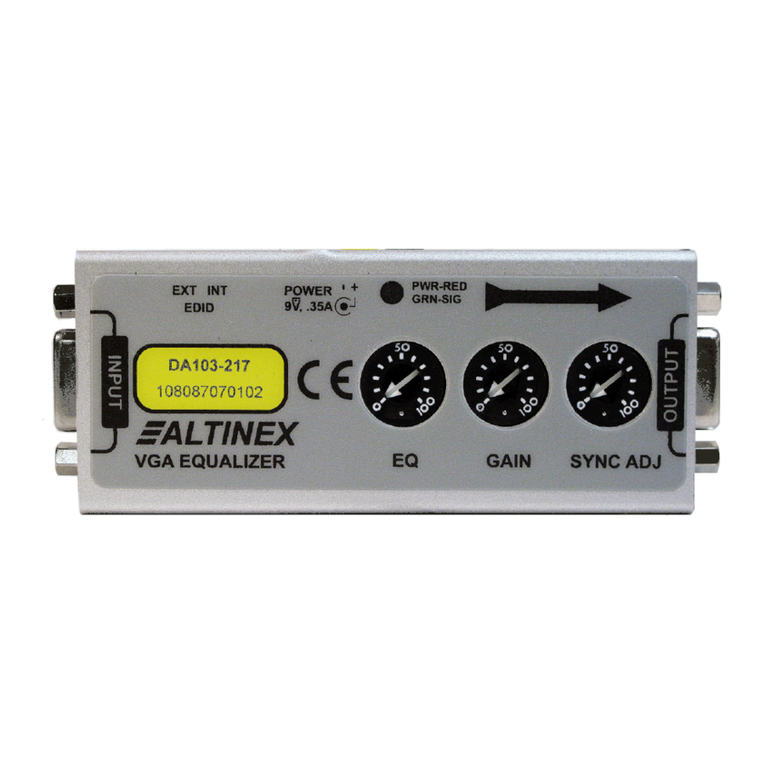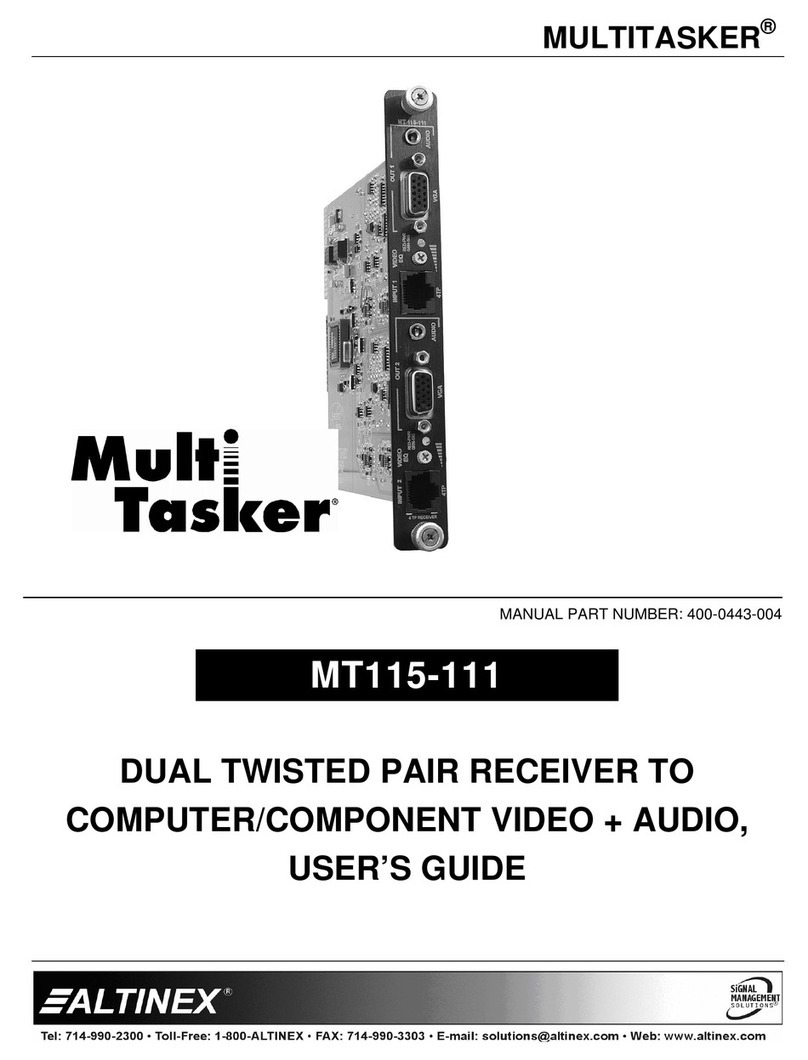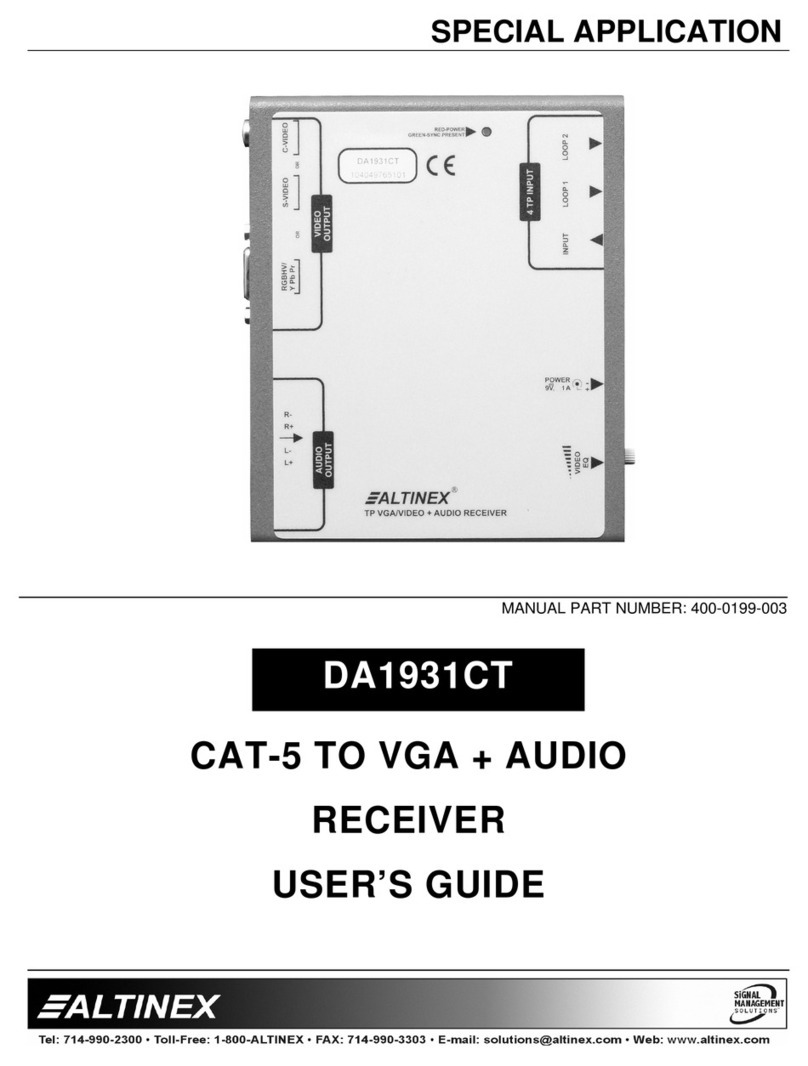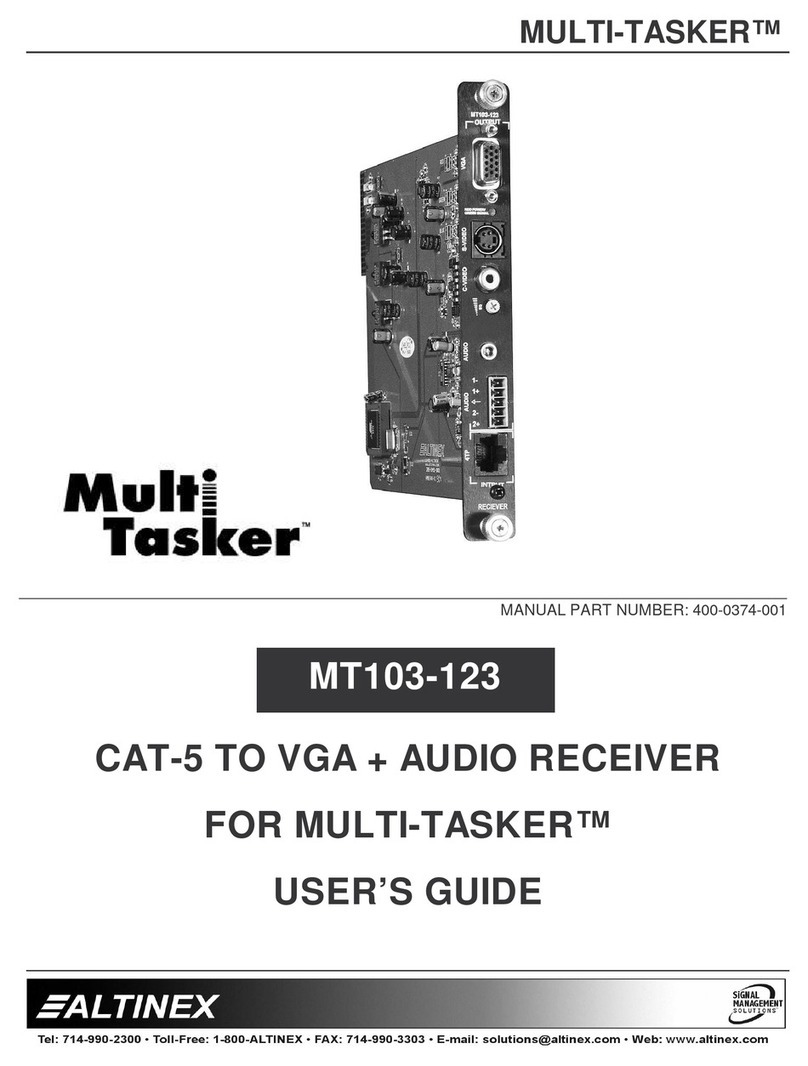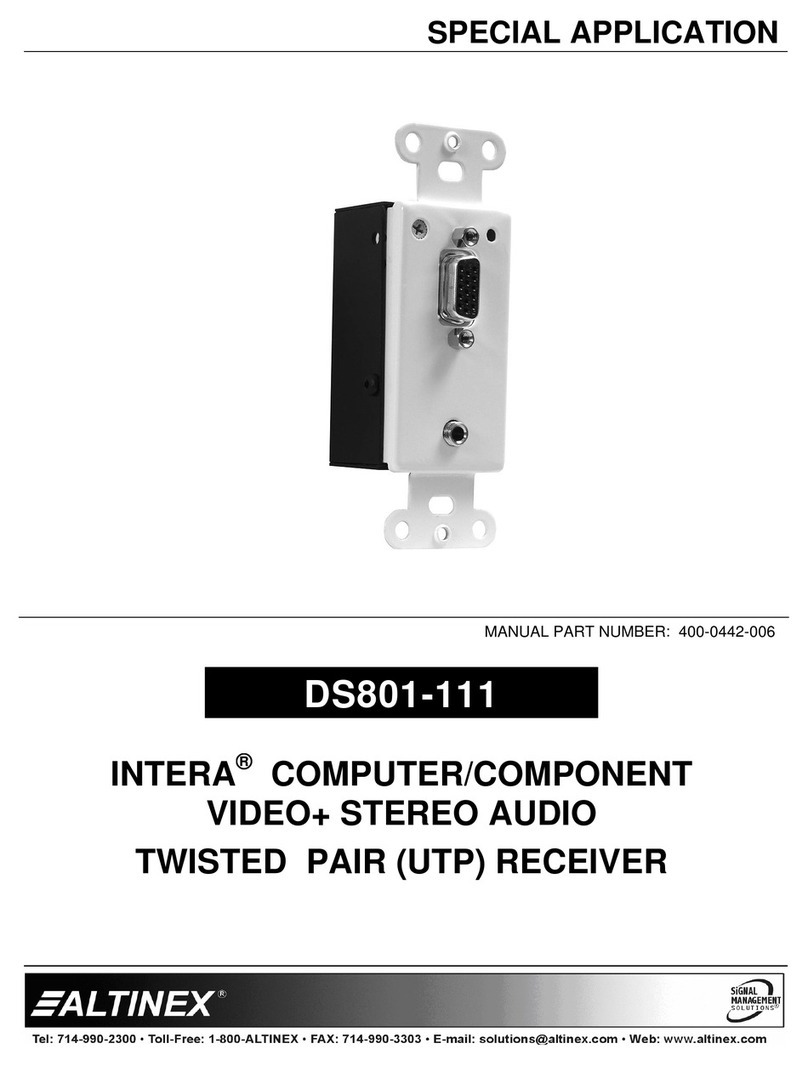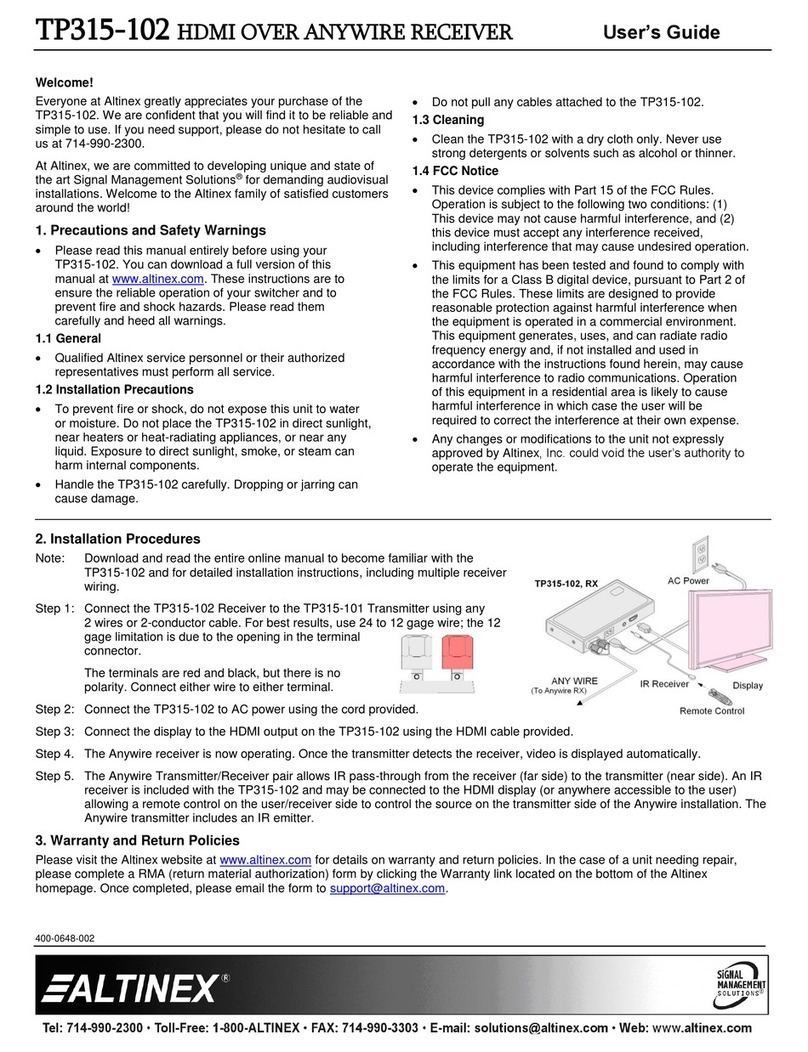
MUSE™: HDMI+POWER+IR Receiver User’s Guide
400-0598-002
Willkommen!
Wir alle hier bei Altinex schätzen Ihren Kauf des MUSE Receivers. Wir sind
überzeugt, dass Sie ihn sowohl zuverlässig als auch benutzerfreundlich finden
werden. Wenn Sie Hilfe benötigen, rufen Sie uns gerne jederzeit an unter
714-990-2300.
Wir widmen uns der Entwicklung einmaliger, moderner Signal Management
Solutions®für anspruchsvolle audiovisuelle Installationen. Willkommen bei
der Altinex Familie zufriedener Kunden auf der ganzen Welt.
1. Sicherheits- und Warnhinweise
Bitte lesen Sie sich diese Anleitung ganz durch, bevor Sie Ihren MU500-112
Receiver verwenden. Sie können die Vollversion dieser Anleitung auf
www.altinex.com herunterladen. Diese Sicherheitsanweisungen sollen den
zuverlässigen Betrieb Ihres MU500-112 Receiver gewährleisten und Brand-
sowie Stromschlaggefahren vermeiden. Bitte lesen Sie sie sorgfältig durch und
beachten Sie alle Warnhinweise.
1.1 Allgemeines
Der MU500-112 Receiver enthält keine wartbaren Teile.
Wartungsarbeiten am Produkt dürfen nur von qualifiziertem ALTINEX
Kundendienstpersonal durchgeführt werden.
Der MU500-112 Receiver wurde auf Sicherheit getestet und trägt die
ETL-Kennzeichnung.
Der MU500-112 Receiver umfasst geschützte Techniken für die
Übertragung von Anzeigestrom und Video über ein CAT-6-
Niederspannungskabel.
1.2 Vorsichtsmaßnahmen bei der Installation
Um Brand- und Stromschlaggefahr abzuwenden, setzen Sie dieses Gerät
niemals Wasser oder Feuchtigkeit aus. Setzen Sie den MUSE Receiver
nicht direktem Sonnenlicht, Heizkörpern oder
hitzeabstrahlenden -Geräten aus, noch sollte er in der Nähe von
Flüssigkeiten aufgestellt werden. Durch direktes Sonnenlicht, Rauch
oder Dampf können die inneren Komponenten beschädigt werden.
Behandeln Sie den MU500-112 Receiver mit Sorgfalt. Stürze oder
Rütteln können zu inneren oder äußeren Schäden führen.
Ziehen Sie nicht an den Kabeln, die am MU500-112 Receiver
angebracht sind.
Für optimale Sicherheit sollte nur dann Strom angelegt werden, wenn
das System vollständig verkabelt ist.
1.3 Reinigung
Reinigen Sie den MU500-112 Receiver nur mit einem trockenen Tuch.
Verwenden Sie keine Reiniger oder Lösungsmittel wie z.B. Alkohol
oder Verdünnungsmittel. Verwenden Sie kein nasses Tuch oder Wasser
zur Reinigung.
1.4 FCC Hinweis
Dieses Gerät entspricht Teil 15 der FCC Regelungen. Betrieb unterliegt
den folgenden beiden Bedingungen: 1. Dieses Gerät darf keine
gefährlichen Störungen verursachen und 2. Dieses Gerät muss mögliche
empfangene Funkstörungen und dadurch verursachte
Funktionsstörungen akzeptieren.
Diese Anlage wurde getestet und unterliegt den gemäß Teil 15 der
FCC-Vorschriften für digitale Geräte der Klasse A festgelegten
Beschränkungen. Diese Grenzwerte sind so ausgelegt, dass sie in
gewerblichen Bereichen einen ausreichenden Schutz vor schädlichen
Störungen bieten. Dieses Gerät erzeugt, verwendet und emittiert
möglicherweise Energie auf Funkfrequenzen, die bei unsachgemäßer
Installation und Verwendung oder unter Nichtbeachtung der
Anweisungen Störungen des Funkverkehrs verursachen kann. Der
Betrieb des Geräts in einem Wohnbereich zieht wahrscheinlich
negative Störungen nach sich, die der Benutzer auf eigene Kosten zu
korrigieren hat.
Veränderungen oder Modifikationen an diesem Gerät, die nicht
ausdrücklich von ALTINEX genehmigt wurden, können bewirken, dass
der Benutzer das Gerät nicht mehr betreiben darf.
2. Installationsverfahren
Hinweis: Das CAT-6 Kabel ist ein wichtiger Bestandteil für die Funktionalität des Geräts. Verwenden Sie ausschließlich empfohlene Kabel für optimale
Leistung. Die Kabelanforderungen finden Sie auf der Seite für technische Angaben.
1. Schritt: Für Einzelheiten laden Sie die gesamte Anleitung unter www.altinex.com herunter und lesen Sie durch.
2. Schritt: Verbinden Sie die HDMI-Quelle mit dem Anschluss des MU500-112 Receivers mit einem
herkömmlichen HDMI-Kabel. Stecken Sie das Stromkabel des Bildschirms in die AC-Buchse am
MU500-112 Receiver.
3. Schritt: Verbinden Sie den MU500-112 Receiver mit einem begrenzten, ungeschirmten CAT-6-Kabel am
MU500-111 Transmitter. Die benötigte Kabelstärke für vollständige Leistung ist AWG23. (Hinweis:
Verwenden Sie nur einen MU400-111 Transmitter mit dem Altinex MU500-112 Receiver)
4. Schritt: Schließen Sie den MU400-111 Transmitter an eine Wechselstromquelle an. Sobald der Transmitter den Receiver erkennt, wird Strom an den Receiver
übertragen, gefolgt vom HDMI-Signal. Es kann einige Minuten dauern, bis der Bildschirm startet und ein Bild zu sehen ist.
5. Schritt: Verbinden Sie den IR-Receiver mit dem MUSE Receiver; stellen Sie die Linse vor dem Bildschirm auf und befestigen sie mit dem beigefügten
Klebeband.
6. Schritt: Der MUSE Receiver ist nun betriebsbereit.
3. Garantie und Rückgaberichtlinien
Bitte besuchen Sie ALTINEX Website unter www.altinex.com und lesen Sie die Einzelheiten über Garantie- und Rückgaberichtlinien durch. Wenn ein Gerät
repariert werden muss, füllen Sie bitte das RMA (Return Material Authorization) Formular unten links auf der Altinex Homepage aus. Dann senden Sie das
ausgefüllte Formular via E-Mail an support@altinex.com.
